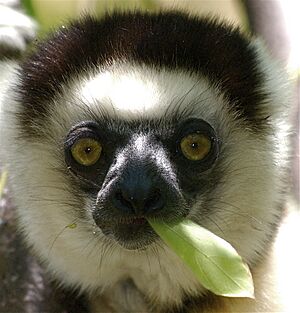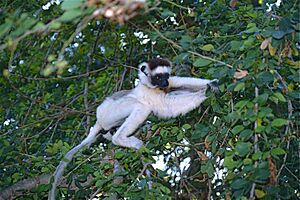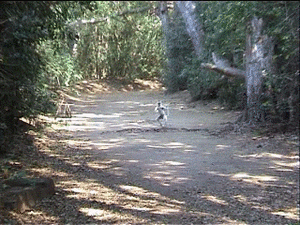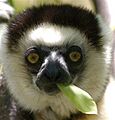Verreaux's sifaka facts for kids
Quick facts for kids Verreaux's sifaka |
|
|---|---|
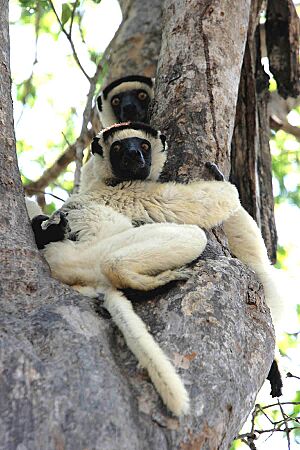 |
|
| Conservation status | |
| Scientific classification | |
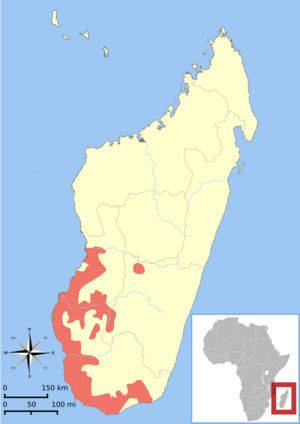 |
|
| Distribution of P. verreauxi | |
| Synonyms | |
|
The Verreaux's sifaka (Propithecus verreauxi), also called the white sifaka, is a medium-sized primate. It belongs to the lemur family called Indriidae. These amazing animals live only on the island of Madagascar. You can find them in many different places, from wet rainforests to dry forests and even spiky thickets.
Verreaux's sifakas have thick, silky fur that is mostly white. They often have brown patches on their sides, the top of their heads, and their arms. Like all sifakas, they have a long tail. This tail helps them balance when they make incredible leaps from tree to tree. Their bodies are perfectly made for living in trees. Because of this, when they are on the ground, they can only move by hopping! They live in small groups, called troops, and search for food together.
Contents
What Does a Sifaka Look Like?
When fully grown, a Verreaux's sifaka's body and head are about 42.5 to 45 centimeters (17 to 18 inches) long. Their tails are even longer, measuring between 56 and 60 centimeters (22 to 24 inches)! Female sifakas usually weigh around 3.4 kilograms (7.5 pounds). Males are a little heavier, weighing about 3.6 kilograms (7.9 pounds).
These sifakas have a flat skull and a wide face. They have special teeth that help them eat their food. Like other lemurs, they have a "toothcomb" at the front of their lower jaw. This is made of their lower front teeth and helps them groom themselves and scrape food. Their back teeth are sharp, like scissors, which helps them shred leaves, fruits, and flowers.
Their bodies are very flexible. They have a wide chest and many bones in their lower back. This allows them to bend and twist easily. Their hips are also designed for flexibility, helping them move through the trees. They have short heel bones, pointed nails, and slightly webbed hands and feet.
What Do Sifakas Eat?
Verreaux's sifakas look for food with their troop. They usually do this in the morning and late afternoon. This lets them rest during the hottest part of the day. They are herbivores, meaning they only eat plants. Their diet includes leaves, fruits, tree bark, and flowers.
They mostly eat leaves, especially during the dry season. They seem to pick their food based on its quality, choosing items with less of a bitter substance called tannin.
How Do Sifakas Behave?
Verreaux's sifakas are active during the day (they are diurnal). They spend most of their time in trees (they are arboreal). You might see them sunbathing with their arms and legs stretched out! They move through the trees by clinging to branches and leaping between them. They can make amazing jumps, sometimes covering 9 to 10 meters (30 to 33 feet) in a single leap! When they are on the ground, they hop on two legs.
They live in family groups, or troops, that can have 2 to 12 sifakas. A group might have one male and one female, or several males and females. Females are usually in charge of the group, making them a matriarchal society.
Each group has a home area, but their areas can sometimes overlap. They protect their food sources rather than their exact boundaries.
Sifakas communicate using different sounds. For example, loud barks are used to warn others about birds of prey, like eagles. When they hear these barks, sifakas look up and climb down trees. Other sounds, like "tchi-fak" calls and growls, can mean different things depending on where the sifakas live. Some groups use them to warn about dangers on the ground, while others use them for general alarms.
Reproduction and Life Cycle
About 45% of female sifakas have babies each year. They are ready to mate between late January and early February. After being pregnant for about 130 days, females give birth to one baby between June and August.
For the first 6 to 8 weeks, the baby clings to its mother's stomach. Then, for the next 19 weeks, it rides on her back. Sadly, about 30% of baby sifakas are eaten by predators like the fossa (a cat-like animal) or large birds like the Madagascar harrier-hawk.
Sifakas that survive grow up and become adults between 3 and 5 years old. Males usually leave their birth group to join a new one. Females, however, tend to stay with their family group.
Conservation Status
The Verreaux's sifaka is listed as Critically Endangered by the IUCN (International Union for Conservation of Nature). This means they are at a very high risk of becoming extinct in the wild. They are also protected under CITES Appendix I, which means international trade of these animals is strictly controlled.
In some parts of Madagascar, the number of sifakas depends on how many large trees are available. It also depends on how much of a certain plant, Allouadia procera, is around, as this plant is very important in their spiny forest home.
A long study in southwest Madagascar showed that one sifaka population was stable, meaning it wasn't in immediate danger of disappearing. However, long periods of dry weather or big changes in rainfall can harm the sifaka population. Protecting their forest homes is very important for their survival.
Images for kids



